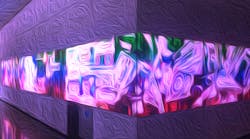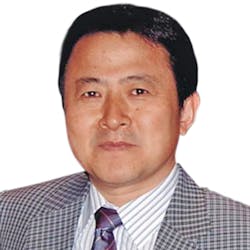This file type includes high-resolution graphics and schematics when applicable.
Yong-Seog Kim, President, Society for Information Display
This article is part of TechXchange: Advanced Display Technology
The current state of the market for TV displays is a mixed bag. On one hand, each visit to the TV department at an electronics store reveals that the selection of available screens is literally bigger than before—more than two-thirds of TV screens now on the market exceed 40 inches in size. At the same time, however, unit growth is sluggish at best, and average selling prices (ASPs) are falling. Consumers are a bit more wary about making a new purchase these days, perhaps in response to having been burned by investing in next-big-things that flamed out.
Of course, it takes a lot of trial-and-error for new technology to take hold, and ongoing innovation has yielded some promising offerings that are already vying, or soon will be, for space in consumers’ living rooms. To get some insight into the state of the market and the potential impact of these display technologies, we tapped several industry experts, each of whom also made a case for his company’s individual approach:
• OLEDs—Dr. Mike Hack, vice president, Universal Display Corp.
• Quantum dots—Jeff Yurek, corporate marketing director, Nanosys Inc.
• Solid-state displays—Eric Li, CEO and president, SiliconCore Technology
This is an exciting time for the display market. Those of us involved with the Society for Information Display have the privilege of regularly getting early peeks at new display technologies—and since we don’t play favorites, we support and encourage them all. Another way to glimpse emerging developments in this industry is to attend Display Week, SID’s annual symposium and tradeshow, where more display innovations are introduced than at any other conference in the world. If this sounds like it’s right up your alley, next year’s event will be held May 21-26 in Los Angeles. We look forward to seeing you there!
Dr. Mike Hack: The Case for OLEDs
1. A flexible display that can be rolled up into a pen is one example of a unique product enabled by OLED technology. (Courtesy of Universal Display Corp.)
What are the benefits of OLED vs. QD LCD and direct-view display technologies?
Quantum-dot LCDs are simply LCDs with an improved color gamut. We believe that OLED technology enables display makers to create differentiated, high-performing, energy-efficient, innovative products. With the numerous benefits of OLED—from its fast response times and extremely high contrast ratios, to its slim, lightweight form factor and ability to be manufactured on plastic (which will usher in new design possibilities for the display industry), to high power efficiency—we believe OLEDs are the best display technology.
There are cost concerns with OLED production. What is UDC doing to address this?
Our strategy is to partner non-exclusively with all major display and lighting manufacturers so as to provide them with the best OLED technology to meet their needs. OLED production costs will reduce with volume; thus, encouraging multiple manufacturers to participate in this business will lead to lower pricing.
Jeff Yurek: The Case for Quantum Dots
2. Two vials of photoluminescent quantum dots are shown next to a prototype blue electroluminescent QD. (Courtesy of Nanosys)
Nanosys has succeeded in lessening the use of cadmium in the manufacturing process. What will be the next steps/areas of focus for improving QD technology quality and safety?
A key focus is working on packaging the materials—these improvements will enable us to package quantum dots in unique new ways, lowering costs and improving the profits of display makers. We are also working on emissive QD displays that are sometimes called QLEDs. We see this approach as the future of QD for displays.
Samsung and TCL are both using your technology. What other TV makers are you working with? What is your projection for when we will see a significant portion of advanced TVs utilizing quantum dots?
I believe we have already reached the inflection point, where we will start seeing quantum dots in a significant portion of the TV market. As an example, Samsung has said that they expect to ship 5 million premium QD TVs in 2016.
Our technology is currently found in TV products from three of the top four TV makers. Brands using our technology include Samsung SUHD, Vizio, TCL, Hisense, and Sharp. We have already delivered more than five tons of quantum-dot materials to customers, and we are able to deliver enough material for more than 18 million 60-in.-class TVs per year.
Eric Li: The Case for Solid-State Displays
3. Solid-state LED displays can be customized to fit specially designed spaces, like this Orchid 1.9-mm display created for Dolby Laboratoriesâ San Francisco headquarters lobby. (Courtesy of SiliconCore Technology)
What are the advantages of SiliconCore SSDs for consumers?
In today’s typical LED display system, you have many elements, such as the control board, interface, Ethernet transponders, lots of memory, and an FPGA. It’s bulky, expensive, and very large, compared to the tiny chip you can create using SiliconCore technology. We created an IC solution for LED. The first generation is 30X smaller and 30X faster due to a massive bandwidth improvement, and reduces the form factor dramatically.
LED has intrinsic properties related to speed and power efficiency. That’s the key reason we’re focusing on LED—high efficiency means high dynamic rate and low power consumption. LED has physical properties that no other device can compete with, so we started there, but are making it more attractive to the consumer. As I mentioned earlier, the SSD technology builds on the proven capabilities of our Common Cathode driver to create a display that has the highest possible brightness and dynamic range, is highly durable and reliable, and is thinner and less bulky than previous LED solutions. It’s a bit like a super-strength LED, without the manufacturing and cost issues associated with OLED.
What will be required to make these displays competitive for the TV market?
One key is using CoB—it makes the display far more rugged as, unlike with SMD, it can’t be damaged by touching, it’s water resistant, and it’s nearly impervious to breakage or short-circuiting because the quality is far better. Cost will matter, but it’s secondary to reliability, quality, and performance. If you can achieve those parameters and make the product very attractive, people will be willing to buy. There are always ways to bring down costs once you’ve proven a technology’s capabilities.
Read more articles in TechXchange: Advanced Display Technology






